engine coolant DODGE GRAND CARAVAN 2010 5.G User Guide
[x] Cancel search | Manufacturer: DODGE, Model Year: 2010, Model line: GRAND CARAVAN, Model: DODGE GRAND CARAVAN 2010 5.GPages: 88, PDF Size: 13.56 MB
Page 9 of 88
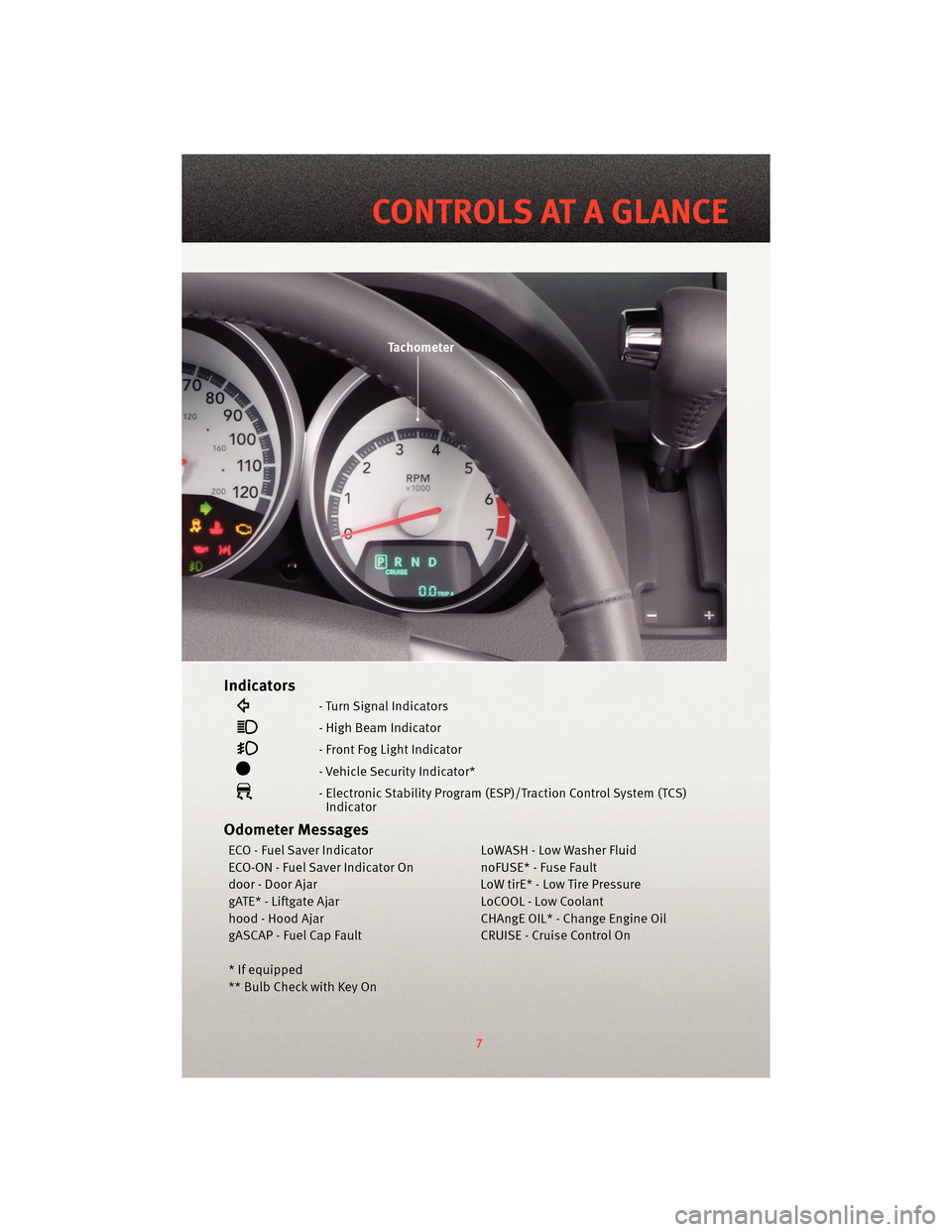
Indicators
- Turn Signal Indicators
- High Beam Indicator
- Front Fog Light Indicator
- Vehicle Security Indicator*
- Electronic Stability Program (ESP)/Traction Control System (TCS)Indicator
Odometer Messages
ECO - Fuel Saver Indicator LoWASH - Low Washer Fluid
ECO-ON - Fuel Saver Indicator On noFUSE* - Fuse Fault
door - Door Ajar LoW tirE* - Low Tire Pressure
gATE* - Liftgate Ajar LoCOOL - Low Coolant
hood - Hood Ajar CHAngE OIL* - Change Engine Oil
gASCAP - Fuel Cap Fault CRUISE - Cruise Control On
* If equipped
** Bulb Check with Key On
7
CONTROLS AT A GLANCE
Page 55 of 88
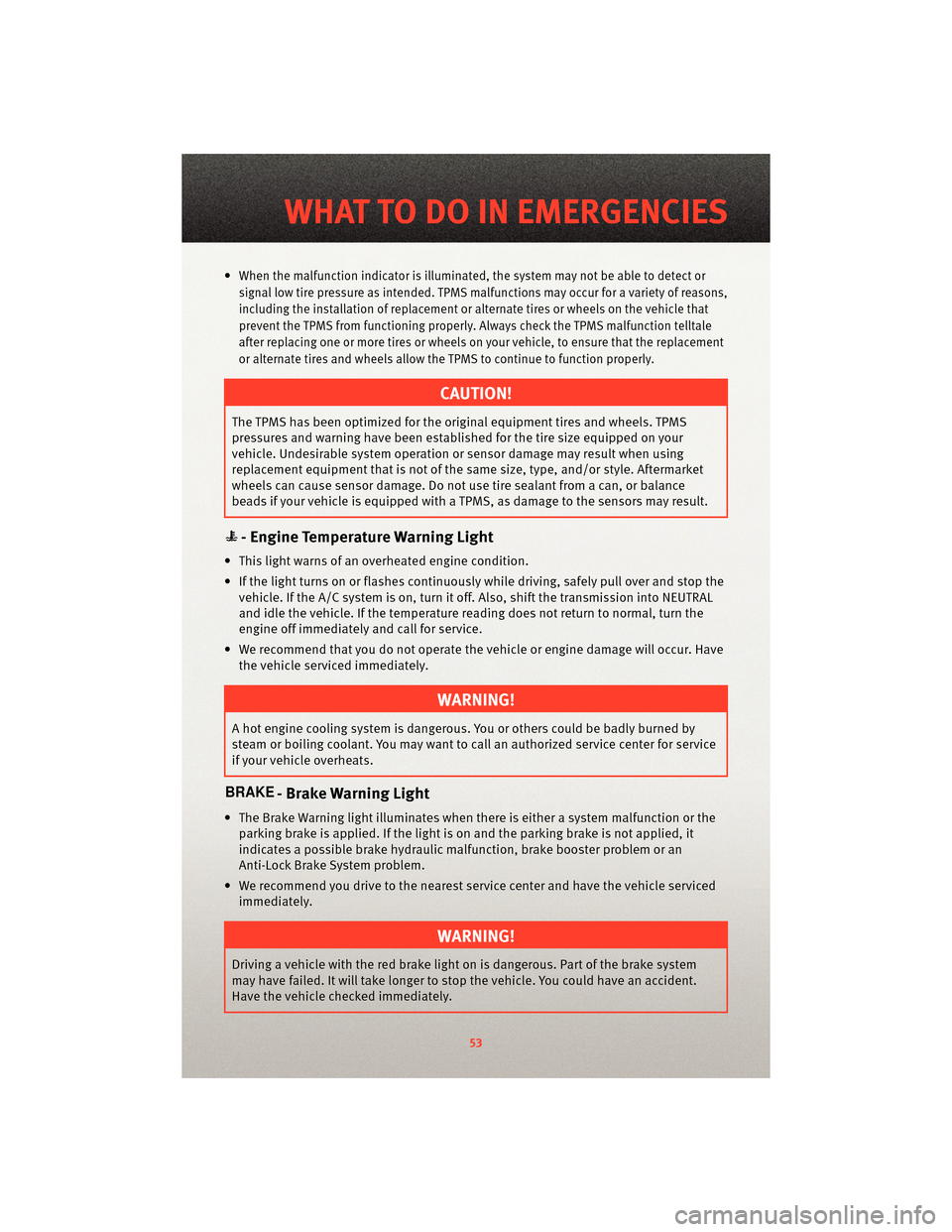
•When the malfunction indicator is illuminated, the system may not be able to detect or
signal low tire pressure as intended. TPMS malfunctions may occur for a variety of reasons,
including the installation of replacement or alt ernate tires or wheels on the vehicle that
prevent the TPMS from functioning properly. Always check the TPMS malfunction telltale
after replacing one or more tires or wheels on your vehicle, to ensure that the replacement
or alternate tires and wheels allow the TPMS to continue to function properly.
CAUTION!
The TPMS has been optimized for the original equipment tires and wheels. TPMS
pressures and warning have been established for the tire size equipped on your
vehicle. Undesirable system operation or sensor damage may result when using
replacement equipment that is not of the same size, type, and/or style. Aftermarket
wheels can cause sensor damage. Do not use tire sealant from a can, or balance
beads if your vehicle is equipped with a TPMS, as damage to the sensors may result.
- Engine Temperature Warning Light
• This light warns of an overheated engine condition.
• If the light turns on or flashes continuously while driving, safely pull over and stop the vehicle. If the A/C system is on, turn it off. Also, shift the transmissioninto NEUTRAL
and idle the vehicle. If the temperature r eading does not return to normal, turn the
engine off immediately and call for service.
• We recommend that you do not operate the vehicle or engine damage will occur. Have the vehicle serviced immediately.
WARNING!
A hot engine cooling system is dangero us. You or others could be badly burned by
steam or boiling coolant. You may want to call an authorized service center for service
if your vehicle overheats.
- Brake Warning Light
• The Brake Warning light illuminates when there is either a system malfunction or the parking brake is applied. If the light is on and the parking brake is not applied, it
indicates a possible brake hydraulic malfunction, brake booster problem or an
Anti-Lock Brake System problem.
• We recommend you drive to the nearest service center and have the vehicle serviced immediately.
WARNING!
Driving a vehicle with the red brake light on is dangerous. Part of the brake system
may have failed. It will take longer to stop the vehicle. You could have an accident.
Have the vehicle checked immediately.
53
WHAT TO DO IN EMERGENCIES
Page 58 of 88
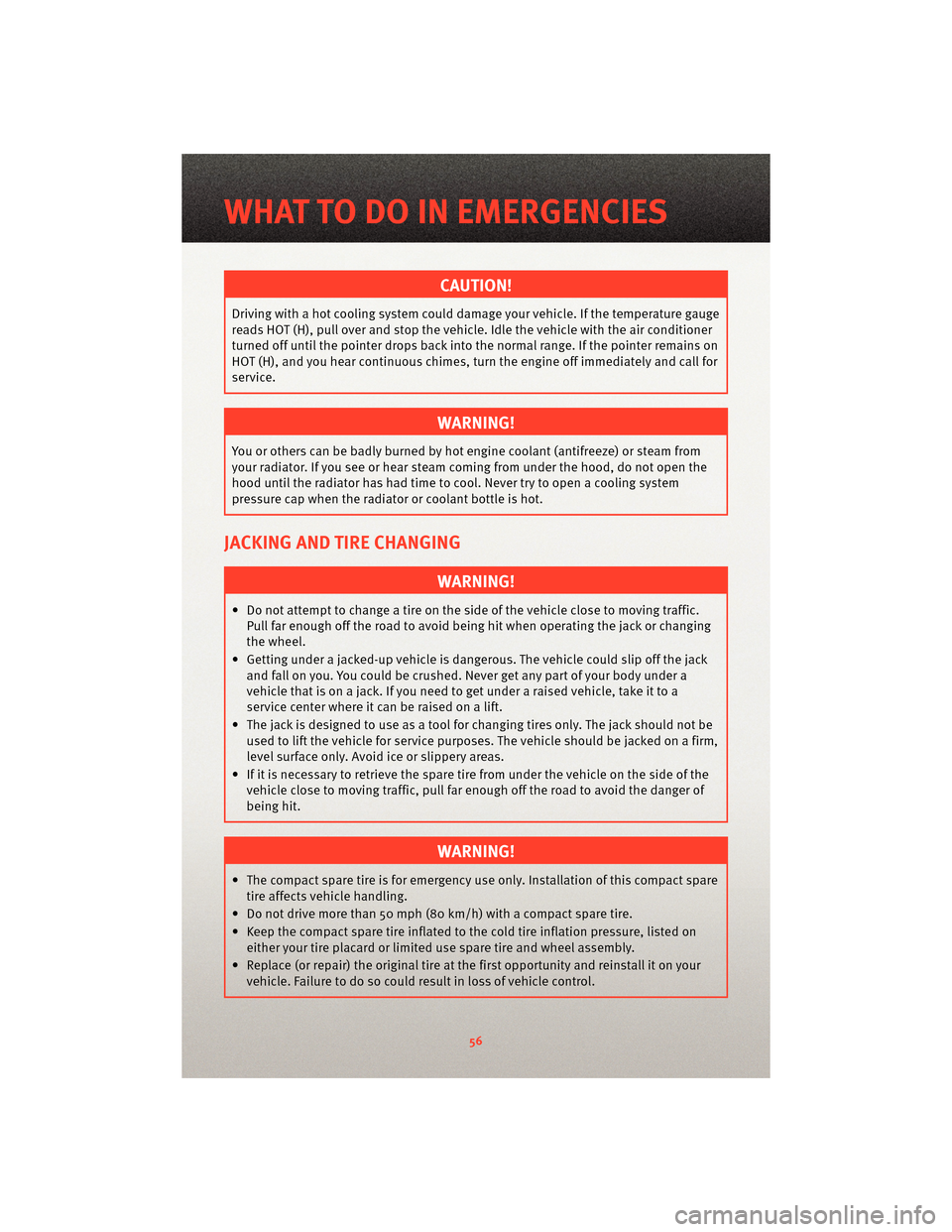
CAUTION!
Driving with a hot cooling system could damage your vehicle. If the temperature gauge
reads HOT (H), pull over and stop the vehicle. Idle the vehicle with the air conditioner
turned off until the pointer drops back into the normal range. If the pointer remains on
HOT (H), and you hear continuous chimes, t urn the engine off immediately and call for
service.
WARNING!
You or others can be badly burned by hot engine coolant (antifreeze) or steam from
your radiator. If you see or hear steam coming from under the hood, do not open the
hood until the radiator has had time to co ol. Never try to open a cooling system
pressure cap when the radiator or coolant bottle is hot.
JACKING AND TIRE CHANGING
WARNING!
• Do not attempt to change a tire on the side of the vehicle close to moving traffic. Pull far enough off the road to avoid being hit when operating the jack or changing
the wheel.
• Getting under a jacked-up vehicle is dangerous. The vehicle could slip off the jack and fall on you. You could be crushed. Never get any part of your body under a
vehicle that is on a jack. If you need to get under a raised vehicle, take it to a
service center where it can be raised on a lift.
• The jack is designed to use as a tool for changing tires only. The jack should not be used to lift the vehicle for service purposes. The vehicle should be jacked on a firm,
level surface only. Avoid ice or slippery areas.
• If it is necessary to retrieve the spare tire from under the vehicle on the side of the vehicle close to moving traffic, pull far enough off the road to avoid the danger of
being hit.
WARNING!
• The compact spare tire is for emergency use only. Installation of this compact sparetire affects vehicle handling.
• Do not drive more than 50 mph (80 km/h) with a compact spare tire.
• Keep the compact spare tire inflated to the cold tire inflation pressure, listed on either your tire placard or limited use spare tire and wheel assembly.
• Replace (or repair) the original tire at the first opportunity and reinstall it on your vehicle. Failure to do so could result in loss of vehicle control.
WHAT TO DO IN EMERGENCIES
56
Page 73 of 88
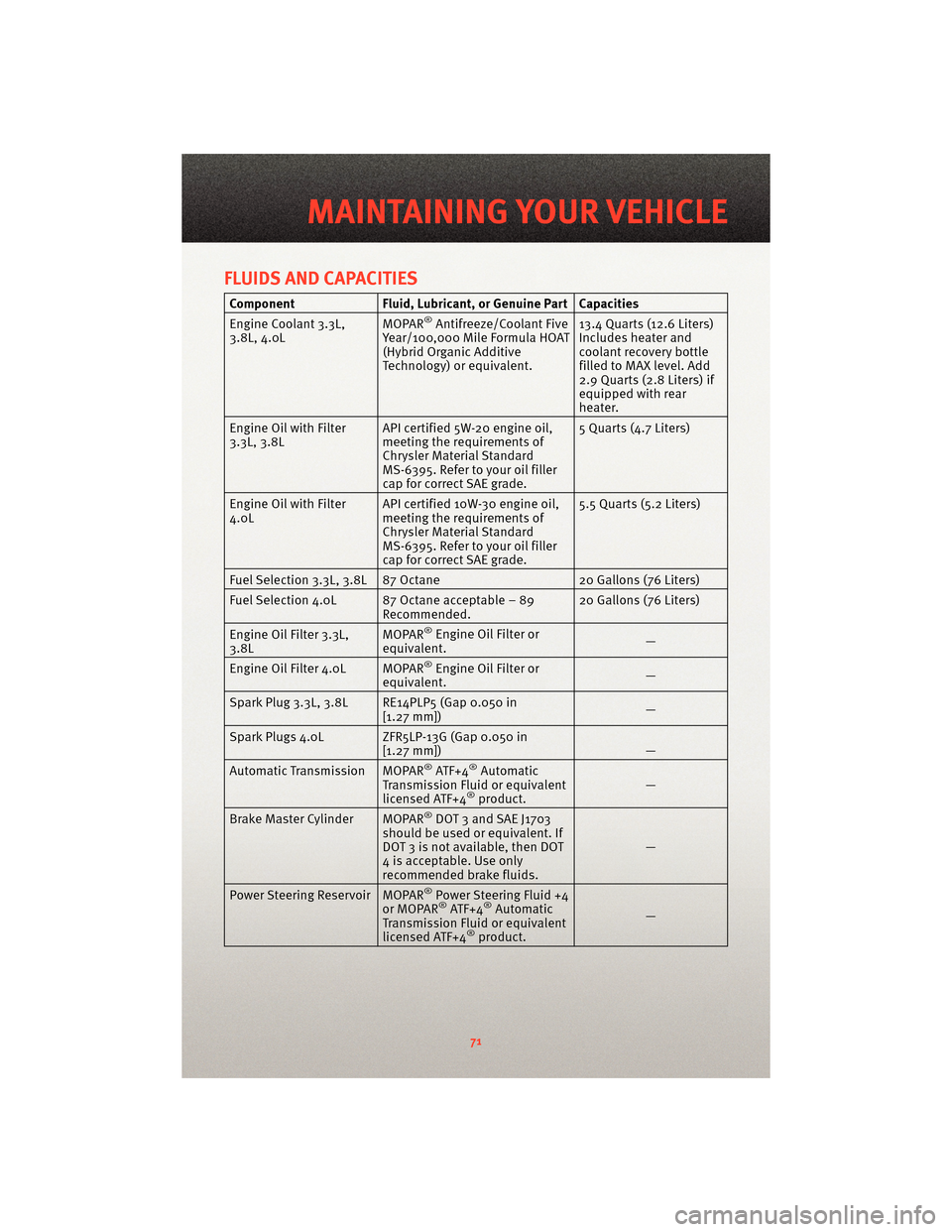
FLUIDS AND CAPACITIES
ComponentFluid, Lubricant, or Genuine Part Capacities
Engine Coolant 3.3L,
3.8L, 4.0L MOPAR®Antifreeze/Coolant Five
Year/100,000 Mile Formula HOAT
(Hybrid Organic Additive
Technology) or equivalent. 13.4 Quarts (12.6 Liters)
Includes heater and
coolant recovery bottle
filled to MAX level. Add
2.9 Quarts (2.8 Liters) if
equipped with rear
heater.
Engine Oil with Filter
3.3L, 3.8L API certified 5W-20 engine oil,
meeting the requirements of
Chrysler Material Standard
MS-6395. Refer to your oil filler
cap for correct SAE grade. 5 Quarts (4.7 Liters)
Engine Oil with Filter
4.0L API certified 10W-30 engine oil,
meeting the requirements of
Chrysler Material Standard
MS-6395. Refer to your oil filler
cap for correct SAE grade. 5.5 Quarts (5.2 Liters)
Fuel Selection 3.3L, 3.8L 87 Octane 20 Gallons (76 Liters)
Fuel Selection 4.0L 87 Octane acceptable – 89 Recommended. 20 Gallons (76 Liters)
Engine Oil Filter 3.3L,
3.8L MOPAR
®Engine Oil Filter or
equivalent. —
Engine Oil Filter 4.0L MOPAR
®Engine Oil Filter or
equivalent. —
Spark Plug 3.3L, 3.8L RE14PLP5 (Gap 0.050 in [1.27 mm]) —
Spark Plugs 4.0L ZFR5LP-13G (Gap 0.050 in [1.27 mm]) —
Automatic Tran smissionMOPAR
®ATF+4®Automatic
Transmission Fluid or equivalent
licensed ATF+4
®product. —
Brake Master Cylinder MOPAR®DOT 3 and SAE J1703
should be used or equivalent. If
DOT 3 is not available, then DOT
4 is acceptable. Use only
recommended brake fluids. —
Power Steering Reservoir MOPAR
®Power Steering Fluid +4
or MOPAR®ATF+4®Automatic
Transmission Fluid or equivalent
licensed ATF+4
®product. —
71
MAINTAINING YOUR VEHICLE
Page 74 of 88
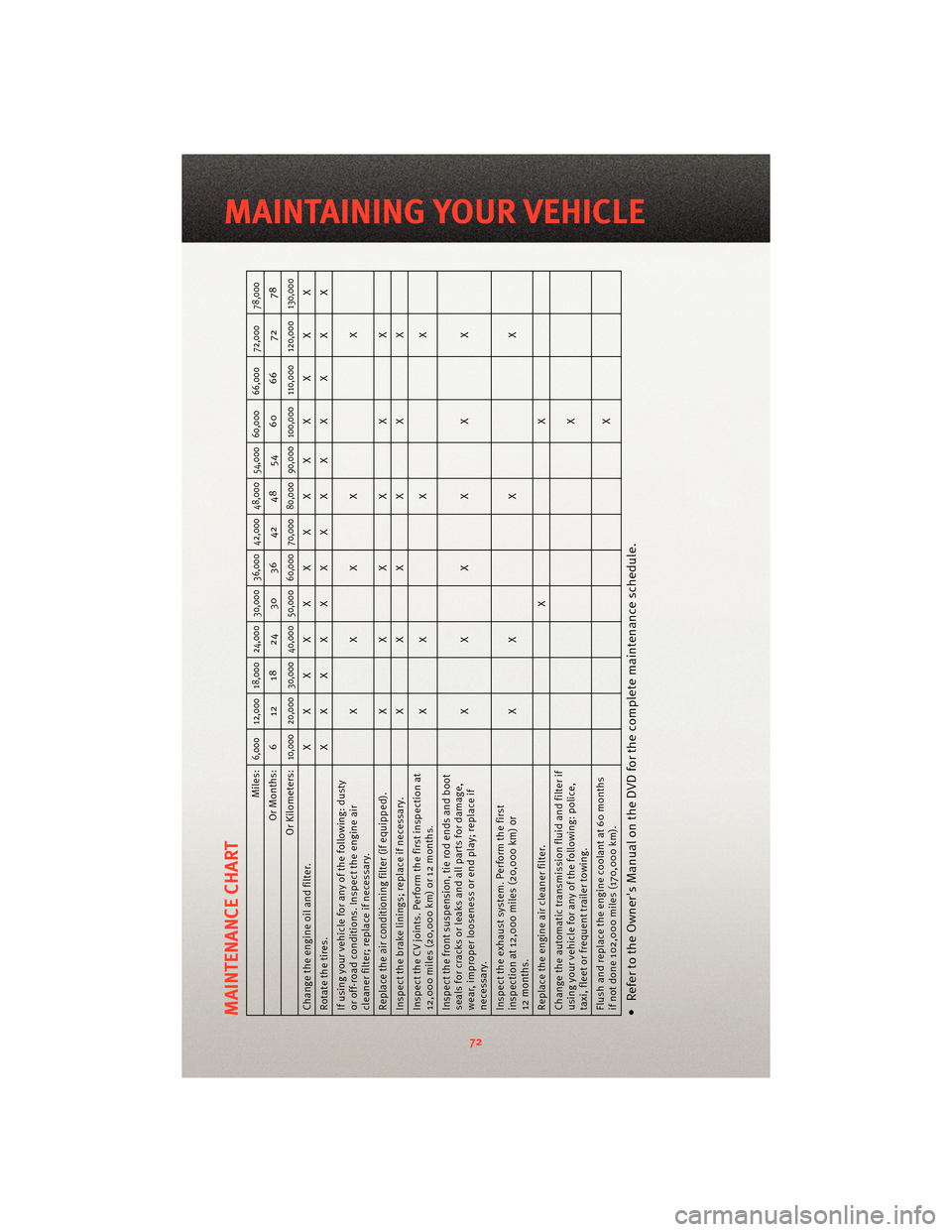
MAINTENANCE CHART
Miles:
6,000 12,000 18,000 24,000 30,000 36,000 42,000 48,000 54,000 60,000 66,000 72,000 78,000
Or Months: 6 12 18 24 30 36 42 48 54 60 66 72 78
Or Kilometers:
10,000 20,000 30,000 40,000 50,000 60,000 70,000 80,000 90,000 100,000 110,000 120,000 130,000
Change the engine oil and filter. XXXXXXXXX X X X X
Rotatethetires. XXXXXXXXX X X X X
If using your vehicle for any of the following: dusty
or off-road conditions. Inspect the engine air
cleaner filter; replace if necessary. XXXX X
Replace the air conditioning filter (if equipped). X X X X X X
Inspect the brake linings; replace if necessary. X X X X X X
Inspect the CV joints. Perform the first inspection at
12,000 miles (20,000 km) or 12 months. XX X X
Inspect the front suspe nsion, tie rod ends and boot
seals for cracks or leaks and all parts for damage,
wear, improper looseness or end play; replace if
necessary. XXXX X X
Inspect the exhaust system. Perform the first
inspection at 12,000 miles (20,000 km) or
12 months. XX X X
Replace the engine air cleaner filter. X X
Change the autom atic transmissionfluid and filter if
using your vehicle for any of the following: police,
taxi, fleet or frequent trailer towing. X
Flush and replace the engine coolant at 60 months
if not done 102,000 miles (170,000 km). X• Refer to the Owner's Manual on the DVD for the complete maintenance schedule.
72
MAINTAINING YOUR VEHICLE